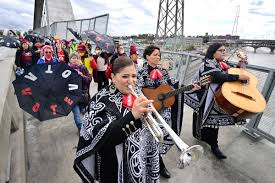
Table of Contents
The surging Hispanic population in the United States has the potential to significantly influence the outcome of elections, particularly in key swing states. As the largest ethnic minority in the country, the Hispanic electorate’s growth is reshaping the political landscape, and both major parties are keenly aware of its importance.
Demographic Shifts and Electoral Impact
Hispanics now make up nearly 20% of the U.S. population, a figure that is expected to continue growing. The states with the most significant Hispanic populations include California, Texas, Florida, New York, and Arizona. Notably, several of these states are battlegrounds where small shifts in voter turnout can determine the overall winner. For instance, in Florida, a state that has historically played a pivotal role in presidential elections, the Hispanic population—comprising Cuban Americans, Puerto Ricans, and other Latino groups—has shown diverse political leanings, making them a critical group for both Democrats and Republicans.
The political influence of the Hispanic community is also evident in states like Arizona, where a rising Latino electorate contributed to shifting the state from a traditionally Republican stronghold to a competitive battleground. The impact was seen in the 2020 election when increased voter turnout among Hispanics played a role in the victories of Democratic candidates in key states.
Voting Patterns and Political Engagement
Historically, the Hispanic electorate has leaned toward the Democratic Party, largely due to its stances on issues like immigration reform, healthcare, and education. However, Hispanic voters are not a monolithic group; their preferences vary significantly based on country of origin, generational status, and socioeconomic factors.
For example, Cuban Americans in Florida have traditionally supported Republican candidates, driven by their strong anti-communist views and concerns about U.S. foreign policy toward Cuba. On the other hand, Mexican Americans, who make up the majority of the Hispanic population in states like Texas and California, have tended to favor Democratic policies, especially on immigration and social services.
Recent trends suggest that Republicans have been making inroads with Hispanic voters, particularly on economic issues, law and order, and social conservatism. In the 2020 election, Donald Trump saw an increase in support among Hispanic voters compared to 2016, particularly in areas like South Texas and Miami-Dade County in Florida. This shift indicates that both parties cannot take Hispanic voters for granted and must actively engage with this demographic to win their support.
Key Issues for Hispanic Voters
Several key issues resonate strongly with Hispanic voters, and candidates who effectively address these concerns are more likely to gain their support:
- Immigration Reform: While immigration is not the only issue for Hispanic voters, it remains a significant one. Many in the Hispanic community are either immigrants themselves or have close ties to immigrant family members. Policies that promise a path to citizenship for undocumented immigrants, protect DACA recipients, and reform the immigration system are generally favored by Hispanic voters.
- Healthcare: Access to affordable healthcare is another top concern. The COVID-19 pandemic disproportionately affected Hispanic communities, highlighting disparities in healthcare access and outcomes. Candidates who advocate for expanding healthcare coverage and addressing these disparities may find strong support among Hispanic voters.
- Economic Opportunity: Economic issues, including job creation, wage growth, and small business support, are also crucial. Many Hispanic voters are concerned about economic stability and upward mobility, and candidates who offer clear plans for economic improvement are likely to resonate with this demographic.
- Education: Education is a high priority for Hispanic voters, particularly policies that improve public schools, increase access to higher education, and address student debt. With a growing number of young Hispanic voters entering the electorate, education policies are becoming increasingly important.
Political Strategy and Outreach
Both parties are investing heavily in outreach to Hispanic voters, recognizing their growing importance in national and state elections. Democrats have focused on issues like immigration reform, healthcare, and social justice, while Republicans are appealing to Hispanic voters on economic issues, religious values, and support for law enforcement.
Effective outreach includes targeted advertising in Spanish, community engagement through local events, and the involvement of Hispanic leaders and influencers in campaign efforts. Moreover, recognizing the diversity within the Hispanic community, campaigns are increasingly tailoring their messages to specific subgroups, such as Mexican Americans, Puerto Ricans, and Cuban Americans.
Conclusion
The growing Hispanic population in the United States is poised to be a decisive factor in future elections. As their numbers continue to rise, so too does their potential to sway election outcomes, particularly in key swing states. Both major political parties must continue to engage with Hispanic voters, address their concerns, and earn their trust to secure their votes. As the 2024 election approaches, the importance of the Hispanic electorate cannot be overstated, and its influence is likely to shape the future of American politics for years to come.








